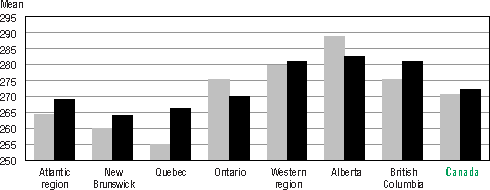
Overall, there has been little change in the distribution of literacy between 1994 and 2003. For Canada, the average prose literacy score for adults aged 16 and over was 270 in 1994 and 272 in 2003. On the document literacy scale, the change was equally slight, from 270 to 271, over the same time period. The Canadian experience was not unique – very little change in literacy proficiency was observed in any of the countries who participated in both international surveys.
Similarly, the average literacy scores of the provinces and regions4 show only small variations over this same period. Generally, the literacy profiles appear to have improved somewhat, with the exception of Ontario and Alberta. However, the only statistically significant changes between 1994 and 2003 were seen in Quebec, where there was an increase in the average prose literacy score from 255 to 266, and in the Atlantic region where there was an increase in the document literacy score from 259 to 267 (Figure 1.4 A and B).
Figure 1.4 A and B

Notes: The Western region includes Manitoba, Saskatchewan, Alberta
and British Columbia.
The Atlantic region includes Newfoundland and Labrador, Nova
Scotia, New Brunswick and Prince
Edward Island.
The northern territories are excluded from the Canadian average.
Source: International Adult Literacy Survey, 1994; International Adult Literacy and Skills Survey, 2003.